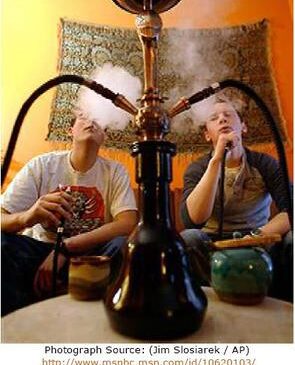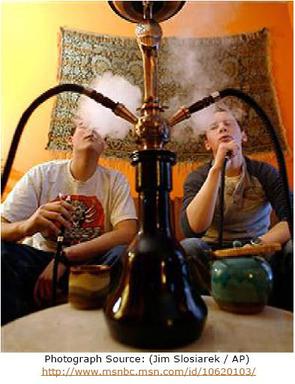Although hookah originated in India, it is a common practice in the Middle East and is now becoming a popular practice in the West (Chaaya et al., 2004). This growing popularity is causing some controversy, as health professionals question its health impact. This week’s Addiction & Humanities describes hookah use in the East and West and the public health significance of this phenomenon.
Middle Eastern immigrants created the first American hookah parlors in their communities; now the demand for hookah is more widespread (AP, 2006). Media reports indicate that restaurants and lounges that offer hookah are predominantly located in college towns (AP, 2006). Hookah cafes often provide solace for busy college students. Hookah parlors typically offer tobacco in various flavors and also offer tobacco free alternatives consisting of flowers and herbs. Proponents of hookah cafes argue that hookah can be an important cultural experience for people from diverse backgrounds who “sit side by side, and share” (Lewin, 2006). However, there is growing concern about the dangers of hookah use. Cathy Backinger, for example, from the National Cancer Institute, asserted the harmful effects of hookah (when smoked with tobacco), saying “some studies show the levels of toxic compounds are at least as high, if not higher, than cigarettes” (Lewin, 2006).
Although there is limited research on hookah use, a few studies have examined hookah’s negative effects. Researchers have linked hookah use with illnesses, such as heart disease, cancer, and pregnancy problems (Maziak, Ward, Afifi Soweid, & Eissenberg, 2004). For example, Chaaya, Jabbour, El-Roueiheb, & Chemaitelly found that 4% of pregnant women in Lebanon smoked arglieh and a quarter of them reported smoking cigarettes and or argileh during pregnancy, (Chaaya, Jabbour, El-Roueiheb, & Chemaitelly, 2004). This observation is important considering that the prenatal risks associated with arglieh use include lung problems and low birth weight. However, many pregnant women are not aware of the risks of hookah use. Less than 9% of the participants correctly identified the dangers of arglieh use. Still, a majority of the women supported the smoking ban for both argileh and cigarettes for those 18 years old and younger. Research should examine the source of these significant discrepancies in attitudes and awareness. Although researchers have examined hookah use in the East, alarmingly there is no empirical evidence about hookah use in the United States. Considering that more than 200 hookah bars have opened in the United States since 2000, there is a need for American research on hookah (Lewin, 2006).
Although these studies illustrate important findings about hookah use, there needs to be more cross-cultural and trend research. For example, American college students might differ from Lebanese college students regarding their knowledge about hookah use or their reasons for hookah use. Twenty-eight percent of college students in Beirut smoked argileh and the majority of the participants were aware of the harmful effects of hookah, but this may or may not be the case for American students (Chaaya et al., 2004). In understanding differences among subpopulations, one can match different and more targeted intervention campaigns. Future studies should determine the common attitudes and beliefs of hookah users as well as hookah’s dangerous effects. Hookah users might have different motivations to smoke. For example, for some hookah users the activity is more of a cultural practice than a recreational one; “ the hookah is 3,500 years old, it’s part of culture, it’s part of religion’ ” (Lewin, 2006). It is also possible that American college students who are fascinated with Middle Eastern culture will be more motivated to use hookah. As a cultural activity, some groups might resist researchers and clinicians who identify health risks from hookah use and attempt to implement prevention programs. It is vital that researchers and health organizations are sensitive to these issues as they encourage a growing awareness about the risks associated with hookah use.
What do you think? Comments can be addressed to Sarbani Hazra.
REFERENCES
AP. (2006, Jan 2 2006). Hookah bars find a place in America. Retrieved July 17, 2006, from
http://www.msnbc.msn.com/id/10620103/
Chaaya, M., El-Roueiheb, Z., Chemaitelly, H., Azar, G., Nasr, J., & Al-Sahab, B. (2004). Argileh smoking among university students: a new tobacco epidemic. Nicotine Tob Res, 6(3), 457-463.
Chaaya, M., Jabbour, S., El-Roueiheb, Z., & Chemaitelly, H. (2004). Knowledge, attitudes, and practices of argileh (water pipe or hubble-bubble) and cigarette smoking among pregnant women in Lebanon. Addict Behav, 29(9), 1821-1831.
Kandela, P. (2000). Nargile smoking keeps Arabs in Wonderland. The Lancet, 356(9236), 1175.





